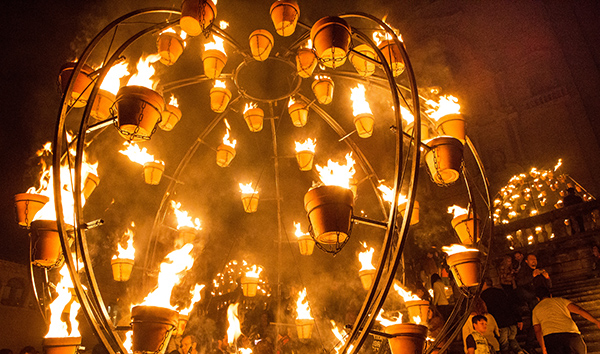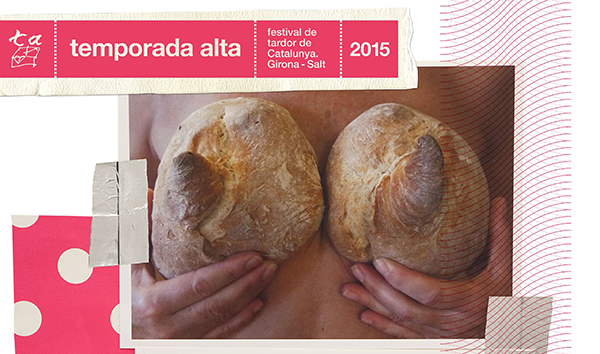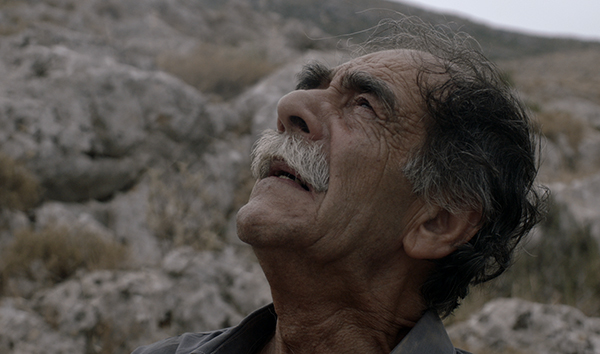2015 edition
The largest event in terms of the number of shows, performances and spectators
Of all the years of the Festival, the twenty-fourth will be remembered for ending with record numbers of shows, performances and spectators. We regard it as the best year so far in terms of the interest and quality of some of the international proposals and the excellent range of productions, but also the commitment of Temporada Alta to the society of Girona. It is also the year of the link between programming and citizenship, with shows such as La cerimònia del foc by the Carabosse company, Please Continue (Hamlet) by Roger Bernat and Made in Girona: Political Mother by Hofesh Shechter.
Shows: 108 (with cinema included)
Co-productions: 22
Premières: 42 (+ 4 films)
Spectators: 78.922 (total) / 91,80% (tickets sold)
Halles: 22 (+ cinema + street)
Budget: 3.128.318,51 €

 Poster 2015, Carlos Pazos
Poster 2015, Carlos Pazos
An image, “pop-ular and a little bit pop”
“I don’t at all like posters that are the work of an artist, trampled over and mobbed by text,” says Carlos Pazos, the creator of the poster for this year’s Temporada Alta: “I have a special interest in design and in graphic design. In fact, when I was younger I devoted myself to graphic design to make a few bob. I find it far more interesting when the collaboration and the work of designers forms part of the work, and is much more, and much better integrated.” For this reason, Pazos created a piece that has a life of its own, on the basis of which the designers Elpulpo Studio made the poster. “I left it slightly open so that they could make their contribution in a way that is more natural and healthier, both for the artist and the designer”.
“I created the whole of the image and some of the text and I suggested to the team of designers that they do the rest however they wanted, and we didn’t have to change anything, they understood the task wonderfully and I think it made them excited. I am very satisfied with the end result: it continues to be a work of Carlos Pazos and, at the same time, the poster is much more interesting,” the artist explained. The team chose some of the typography and the artist had left the space for the festival’s logo to be incorporated. But the collaboration between the one and the other was not limited to the designers simply following a thread in order to weave the artist’s instructions. “They also included the enlargement of an image that I had stuck on because, as nearly always, I made a collage, and they put it over the image that I had put there. The collaboration has been stimulating for them and the result has been wonderful for me.” As for the typography, the artist made use of a case from a popular brand of champagne for some of the letters of the word “Temporada” (season) and the strip with polka dots on the left comes from a luxurious brand of underwear: “I wanted the image to be pop-ular and a bit pop”.
The central theme of the poster of this year’s festival is the mask, introduced through the two images where a man rests, in front of breasts and genitals, three loaves of bread. The images themselves were created by Pazos and come from his archive. “I didn’t make them expressly for the poster. I have an archive of images, made by me, or cut out, of ideas, and when I am given a commission, I start to look through them. I found it quite intriguing to change these loaves into a mask. They are one, but in a different way.”
The enlarged image of which Pazos speaks is the rabbit ‘Thumper’, (Tambor in Spanish) from the Disney classic, Bambi. “I work a lot with images and memories from my childhood. He was a character who always cried out for attention. When I was a child, there was a program on Radio Barcelona that was called ‘Tambor”. Tambor was always hitting the ground with his left paw as a call for attention. I’ve used it as a reminder of this character who draws the attention of those passing by to something significant so that they notice it.” “I am a great lover of animals and much less of human beings which is why I like, as I have done in this case, to ridicule human beings. There are many theatrical authors who have done this and have exalted animals. I am still a great admirer of Walt Disney and he always played with the humanization of animals. The animals can also represent a Shakespearean reference but, in general, I use them because I really like them, I think they are wonderful beings.”
All in all, “I’m not a great lover of the theatre, but that doesn’t mean I don’t go to the theatre,” concludes Carlos Pazos. “I’m a fan of cinema and music, but I don’t have a great theatrical culture.” But, as an artist living in Paris for a good part of the year, “I tend to watch performances of works by Thomas Bernhard, of which there are many, although I’m more interested in the author than the show.”
At this point, it’s a truism to say that the posters of the Temporada Alta are the work of the most outstanding Catalan artists of recent decades, such as Antoni Tàpies, Antoni Miralda, Jaume Plensa, Eulàlia Valldosera, Perejaume, Frederic Amat and Eugènia Balcells. “Carlos Pazos, a deserter from architectural studies, the well-to-do son of a family steeped in the widespread Francoist and noucentista atmosphere that characterized much of the local bourgeoisie of the post-war period, gradually became known in the early 70’s, in the context of conceptual practices,” says art historian and critic Martí Peran. “Even so, his empathy with the group was little more than strictly generational. Carlos Pazos was only a conceptual artist to the extent that the term is used to indicate the more or less radical designs which were leading the rebirth in the Catalan art from the mid-1960s and the late 1970s.” “The epithet conceptual art is, in reality, very eclectic for the local context,” continues the text. “Within it, as has been suggested, it accommodates various ‘povera’, ephemeral or objectualist poetics which, in different ways, were opposed to the conventions of abstract modernism and realism, then prevailing throughout the Spanish territory. Here then, even practices belonging to the language Pop Art could also, to a certain extent, be contemplated within the generous epithet of Conceptual Art. In fact, this is the ambiguous zone where Carlos Pazos is usually placed, in the strange hybridization of Pop and Conceptual Art that apparently serves as a wildcard to locate certain “slippery” artists of the 1970s (alongside Pazos, there is also the work of Albert Porta, Jordi Galí, a bit of Silvia Gubern, and even an artist as elusive as Angel Jové).
The link between Carlos Pazos and Pop art is evident, but many points need to be specified. The artist himself claimed that his primary sources were “pop and arte povera” and certainly there are many parallels between his work and, for example, the Bunk series that Eduardo Paolozzi republished in 1972. However, the works of Carlos Pazos, when he became known in 1971 (Anell, Abrillantador, Les enfants terribles…) are much closer to the surrealist aim – in the way Meret Oppenheim is understood – than the purist Pop Art of North America or to the topics – alongside objects of great evocative potential, the interest in technology and machinism – that were articulated by the British Independent Group of Richard Hamilton. The Pop that interested Carlos Pazos is, in fact, the more ” brut”, derived from Duchamp and neo-Dadaism and which points to Warhol, Rauschenberg and the French nouveax réalisme.”
Antoni Ribas
Carlos Pazos
Chronology taken from the catalogue of the exhibition that the artist has on show up to the end of July at the Centre d’Art Contemporani Piramidón: “Bisturí o arsénico”. Carlos Pazos a la col·lecció de Piramidón, Centre d’Art Contemporani. Not to be missed.
He had his first individual exhibition in 1970 and his first retrospective, “No me digas nada”, in 2007, at the MACBA (Museu d’Art Contemporani de Barcelona) and at the MNCARS (Museo Nacional Centro de Arte Reina Sofía). Premi de la Comunidad de Madrid 2003, Premi Nacional d’Arts Plàstiques 2004 and Premi Nacional d’Arts Visuals de Catalunya 2008. He is an ‘undisciplined’ artist, which allows him to use the most suitable media for whatever he wants to do at any particular moment: collage, sculpture, film, photography, installation or performance. Always in love with the music and the night, he ran the Salón de Baile Cibeles (1978-1982) with a capacity of 800 people and two live salsa and swing orchestras; the cocktail-bar, Bijou (1983-1986) and the music bar, Je-rrix (1994-95). Here he established the headquarters of his ‘Club de Fans’, the activities of which were relaunched in 2014 with the project, CP Selection, arising from participation in the Over 60 revolutions program of the Academia de España in Rome. Always in love with books and letters, in 2004 the University of Barcelona published his first book of texts Garabatos y Zarpazos, republished in 2007. The second book, Pimpollos y Papanatas, was published by Comanegra in February 2013. In love with cinema from the very beginning, in the ’60s and ’70s he made some super-8 films of which few remain. In 1987 he appeared as the protagonist in a film by Jordi Cadena, ‘Es quan dormo que hi veig clar’, based on texts by the poet J.V. Foix and, in 2006, wrote and directed Mnemocine. Película recortable which is 26 minutes long and consists of 11 audiovisual fragments. Renewing his passion for music and taking advantage of the invitation to exhibit at the Centro para el Desarrollo de las Artes Visuales in Havana, he shot the film Yo inventé unos Llopis which was shown at the Casa Encendida in Madrid in June 2012, at the Cinema Ciutat in Palma de Mallorca in September of the same year, at the Filmoteca de Catalunya in February 2013 and the Real Academia de España in Rome in March 2014. In September 2014, he presented the first phase of the project For CP Fans Only Portàtil, physically located on the premises of the Zedis factory in Lliçà d’Amunt. It consists of 13 transportable sheds which house a substantial portion of Carlos Pazos’ works, organized by topic and/or chronologically, depending on the circumstance, the aim being that his work can travel with ease from one side of the planet to the other. Currently, continuing his passion for art and literature, he is preparing a feature-length film titled Artíssimo, collage para leer, which will be shown in September at the Museo Nacional Centro de Arte Reina Sofía, Madrid.
Download poster
HIDE
 Short film 2015, Tragedy, the Song of the Goat
Short film 2015, Tragedy, the Song of the Goat
The Gold winner of the Laus Award at the 2015 short film festival.
The short presentation from the XXIV edition of Temporada Alta, explains with sensitivity and a strong poetic tone how Theatre was born over 2500 years ago with a story that takes place in modern day Greece. Now that Greece and culture are going through such a difficult time, we want to reclaim both Greece and culture itself.
An old man nostalgically explains the origin of the Greek tragedy and the origins of our culture. With a legendary and timeless story which leaves us speechless, reflecting on the short distance between Ancient Greece, the tragic mother of all European cultures, and modern day Greece, punished by a Europe that seems to have forgotten the key to its cultural roots. But this man reminds us, with some difficulty, where we are and where we come from, emphasising that there is still a place for hope of a future revival. To be reborn we have to recognise darkness, be willing to die, a visual metaphor about life and death that is repeated throughout the account.
The short film aims to portray Temporada Alta as a protective fortification of the values and the human attitude that has guided us along our path to gain knowledge from theatre’s beginnings. It is our Tragedy, at the root of everything.
The documentary, which was filmed with the help of 20 citizens from the local area between the 1 and 7 August in Greece and Albania, is aimed at all types of audiences, and although the original language is Greek, the short film will be subtitled in Catalan, Spanish and English.
Film crew
Production: Nanouk Films
Director: SS (Salvador Sunyer i Sergi Cameron)
Production Designer: Víctor Santacana
Director of Photographiy: Miquel Martínez Miró
OST: Diego Pedragosa i Sergi Cameron
Sound Design: Marc Bech (Coser y Cantar)
AWARDS
Laus d’Or (audiovisual category)
HIDE


 Short film 2015, Tragedy, the Song of the Goat
Short film 2015, Tragedy, the Song of the Goat